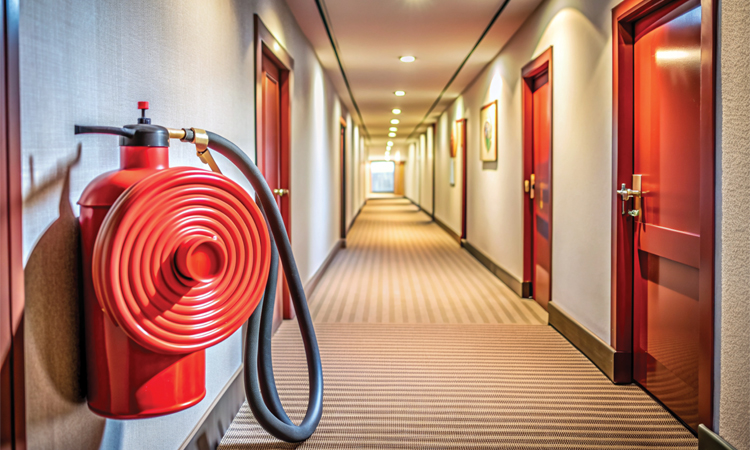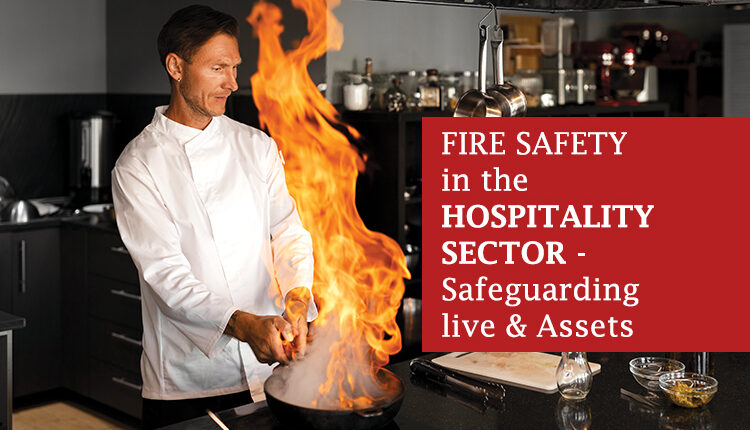The hospitality sector promises safety, comfort, and memorable experiences. Guests arrive with the expectation that hotels, restaurants, and resorts are safe havens where they can relax without concern.
Yet, behind the welcoming smiles and luxurious facilities, fire hazards pose one of the greatest risks to life and reputation.
Unlike industrial plants where risks are largely confined to trained workers, hotels must protect hundreds of guests—most of whom are unfamiliar with the premises.
Add to this round-the-clock operations, commercial kitchens, electrical loads, and decorative but often combustible interiors, and the vulnerabilities multiply.
India’s hospitality sector has witnessed several high-profile fire incidents in recent years. These tragedies not only highlight recurring lapses but also underline the urgent need for a holistic fire safety culture
Understanding Fire Risks in Hospitality
Fire hazards in hotels and restaurants typically arise from:
• Kitchens: Open flames, overheated oils, and grease accumulation in ducts are frequent triggers.
• Electrical faults: Short circuits, overloaded circuits, or malfunctioning air conditioners spark fires.
• Heating and cooling systems: Boilers, furnaces, and HVAC units may overheat if neglected.
• Guest negligence: Smoking in non-smoking rooms, unattended candles, or misuse of appliances.
• Interiors and décor: Flammable upholstery, curtains, and wooden paneling can accelerate fire spread.
• Event spaces: Temporary electrical setups for banquets or conferences add hidden risks.
While these hazards are universal, Indian case studies show how lapses in design, enforcement, and emergency response often convert small mishaps into large-scale tragedies.
Lessons from Indian Hotel Fires
Kolkata’s Rituraj Hotel Fire (April 2025)
One of the deadliest recent tragedies, this fire killed 14 people, including two children. Thick smoke trapped guests as the building’s glass enclosure prevented ventilation. A narrow single staircase acted as a choke point, and illegal structural modifications worsened escape conditions.
Most victims succumbed to asphyxiation. Investigations revealed gross violations of fire norms, leading to arrests of the owner and manager.
Patna Restaurant & Hotel Fire (April 2024)
A cooking gas cylinder explosion in a restaurant spread to an adjoining hotel, killing six and injuring twenty. With flammable interiors and poor compartmentalization, fire engulfed multiple floors before brigades could intervene.
Dozens escaped by jumping from windows—highlighting the absence of usable escape routes.
Hotel Arpit Palace, Delhi (2019)
Seventeen people died in this Karol Bagh hotel fire, reportedly caused by a short-circuit. Locked exits, combustible wooden interiors, and jammed windows turned the building into a trap. Firefighting operations were hampered by congestion in the locality.
The tragedy revealed how budget accommodations often cut corners on safety compliance.
Swarna Palace, Vijayawada (2020)
Repurposed as a COVID-19 quarantine center, the hotel saw 11 fatalities after an electrical short-circuit.
Investigations exposed that the building’s fire clearance had lapsed, and emergency systems were non-functional. The case demonstrates the dangers of temporary adaptive use without safety reassessment.
Ajmer’s Hotel Naaz Fire (2025)
A blaze in a five-storey hotel killed four, including a child. Families alleged glaring safety violations, from lack of sprinklers to blocked staircases.
The fire, suspected to have originated in an air-conditioning unit, points again to poor electrical maintenance.
Common Threads in Indian Cases
Across these incidents, recurring patterns emerge:
• Combustible interiors: Wooden panels, fabrics, and cheap décor accelerated fire spread.
• Poor layout and ventilation: Narrow staircases, blocked exits, and sealed rooms trapped occupants.
• Expired or missing NOCs : Hotels often operated with lapsed fire clearances or inadequate compliance.
• Unauthorized structures: Illegal extensions compromised both prevention and evacuation.
• Untrained staff: In many cases, employees panicked or failed to guide guests effectively.
• Delayed response: Lack of early detection systems meant fires grew before alarms were raised.
These failures underscore that fire safety in hospitality is as much about culture and accountability as it is about technology.
Building a Fire Safety Culture
Fire safety in hotels is not merely regulatory—it must be ingrained in daily operations.
• Staff training and drills: All employees, from front desk to housekeeping, must know evacuation routes, alarm triggers, and guest assistance protocols.
• Guest awareness: Rooms should display evacuation maps and simple instructions in multiple languages.
• Management leadership: Owners and managers must treat fire safety as a core part of service excellence, not a tick-box compliance exercise.
In many tragedies, such as Delhi’s Arpit Palace, staff lacked even basic fire-drill knowledge. A culture of preparedness could have saved lives.
Fire-Safe Design Principles
The physical layout of a hotel can either contain a fire or turn it into a deathtrap. Essential design measures include:
• Compartmentalization: Fire-rated walls and doors to prevent rapid spread.
• Multiple exits: Wide, clearly marked, and unobstructed staircases are non-negotiable.
• Ventilation systems: Prevent smoke buildup—the silent killer in most hotel fires.
• Automatic detection & suppression: Smoke detectors, heat sensors, and sprinklers installed across all guest areas, kitchens, and corridors.
• Fire-resistant materials: Flame-retardant carpets, curtains, and upholstery reduce fire load.
In Kolkata’s Rituraj case, the absence of smoke ventilation turned corridors into gas chambers. Safe design could have reversed the outcome.
Kitchen and Electrical Safety
Kitchens remain hotspots of fire hazards. Measures include:
• Regular cleaning of hoods, ducts, and filters to prevent grease buildup.
• Installation of wet-chemical suppression systems to extinguish oil fires.
• Strict adherence to safe storage of LPG cylinders and chemicals.
Similarly, electrical systems demand:
• Regular inspection of wiring, sockets, and appliances.
• Avoiding overloading circuits, particularly during weddings or conferences.
• Using certified equipment and surge protection devices.
The Patna and Vijayawada fires highlight how overlooked maintenance in these areas can quickly turn fatal.
Technology and Modern Solutions
The hospitality sector can leverage smart safety solutions:
• IoT-enabled detectors for smoke, heat, and gas leaks.
• Dynamic evacuation systems with illuminated signage that adapts during emergencies.
• Thermal imaging cameras to detect hotspots in electrical rooms.
• Integrated building management systems (BMS) that automatically shut down elevators and control ventilation during fires.
Such systems not only improve outcomes but also enhance guest confidence. Regulatory Compliance and Enforcement
Regulatory Compliance and Enforcement
Compliance with National Building Code of India (NBC), state fire safety rules, and international standards such as NFPA codes must be non-negotiable. Authorities must conduct regular surprise checks, and NOCs should be tied to real audits, not paperwork.
The Rituraj Hotel case, where the establishment operated despite blatant violations, shows why enforcement needs teeth: heavy fines, closure, and criminal liability for offenders.
Emergency Preparedness and Response
Even the best prevention cannot eliminate all risk. Hotels must:
• Maintain clear evacuation plans and display them in rooms and lobbies.
• Designate safe outdoor assembly areas.
• Train in-house firefighting teams to use extinguishers and hydrants.
• Build partnerships with local fire brigades for rapid response.
Preparedness converts panic into coordinated action, minimizing casualties.
Fire Safety and Sustainability
• Modern hospitality increasingly aligns fire safety with sustainability:
• Eco-friendly suppression agents that avoid ozone depletion.
• Energy-efficient appliances that reduce overheating risks.
• Fire-resistant green materials in construction.
• Proper waste management to avoid combustible buildup.
This synergy strengthens safety while reinforcing a hotel’s environmental responsibility.
Protecting Reputation and Trust
For hotels, reputation is everything. A single fire can devastate years of goodwill, as seen in the aftermath of Delhi’s and Kolkata’s tragedies. Guests equate visible fire safety measures—sprinklers, signage, trained staff—with professionalism and reliability.
Embedding fire safety is therefore not just about compliance but about preserving trust, brand value, and business continuity.
Conclusion – From Tragedy to Transformation
Indian case studies make one truth starkly clear: most hotel fires are preventable. Recurring failures in design, maintenance, training, and enforcement continue to cost lives. But they also serve as painful lessons.
By embracing fire-safe infrastructure, strict compliance, staff preparedness, and smart technology, the hospitality sector can transform safety from a weak link into a cornerstone of guest experience.
Ultimately, hospitality is not just about luxury and comfort—it is about safeguarding every guest, every employee, and every memory created within those walls. Prevention is not just protection; it is the very essence of hospitality.


